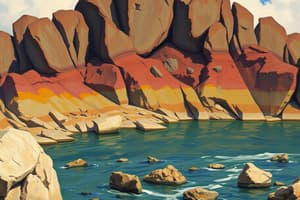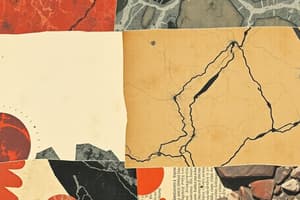Podcast
Questions and Answers
What is the term 'igneous' derived from?
What is the term 'igneous' derived from?
- Earth
- Fire (correct)
- Air
- Water
At what temperature are igneous rocks formed?
At what temperature are igneous rocks formed?
not lower than 700°C
Igneous rocks form from the solidification of ____ or lava.
Igneous rocks form from the solidification of ____ or lava.
magma
It is possible to see the small crystals in volcanic igneous rocks with the naked eye.
It is possible to see the small crystals in volcanic igneous rocks with the naked eye.
Which type of rock forms when magma crystallizes within the crust?
Which type of rock forms when magma crystallizes within the crust?
What process is referred to as lithification?
What process is referred to as lithification?
Which of the following is a non-clastic sedimentary rock?
Which of the following is a non-clastic sedimentary rock?
The four main parts of diagenesis are compaction, cementation, recrystallization, and ____ changes.
The four main parts of diagenesis are compaction, cementation, recrystallization, and ____ changes.
What type of igneous rock is formed at the Earth's surface?
What type of igneous rock is formed at the Earth's surface?
Magma that crystallizes deep underground forms small crystals.
Magma that crystallizes deep underground forms small crystals.
Flashcards are hidden until you start studying
Study Notes
Types of Rocks
- Rocks are classified into three main categories: igneous, sedimentary, and metamorphic.
- Learning competency includes identifying and classifying these rock types.
Igneous Rocks
- Derived from the Latin word "ignis," meaning fire; formed through the solidification of magma or lava.
- Requires high temperatures (not lower than 700°C) to form.
- Common minerals in igneous rocks include quartz, feldspar, pyroxene, olivine, amphibole, and mica.
Formation of Igneous Rock
- Characterized by an intergrowth of crystals and/or volcanic glass.
- Crystal size is proportional to the cooling rate of magma: larger crystals form at greater depths, while smaller ones form near the surface.
Types of Igneous Rocks
- Extrusive Igneous Rocks: Formed from magma or volcanic fragments that erupt and solidify on the surface; typically fine-grained with tiny, indistinct crystals.
- Intrusive Igneous Rocks: Form when magma crystallizes within the Earth's crust, exhibiting medium to coarse grains; also known as plutonic rocks.
Naming of Igneous Rocks
- Naming uses a binary system based on texture and composition (silica content).
- Common classifications include:
- Felsic: Rhyolite (extrusive), Granite (intrusive)
- Intermediate: Andesite (extrusive), Diorite (intrusive)
- Mafic: Basalt (extrusive), Gabbro (intrusive)
Sedimentary Rocks
- Formed from organic, mechanical, or chemical sediments through a process called lithification.
- Example: Coquina, made from seashells or coral.
Formation of Sedimentary Rock
- Diagenesis includes processes where sediments become lithified. The four main steps are:
- Compaction
- Cementation
- Recrystallization
- Chemical changes (e.g., oxidation/reduction)
Types of Sedimentary Rock
- Non-clastic Sedimentary Rocks: Can be biological, chemical, or a combination of both.
- Key examples include:
- Chert and Flint (light and dark color variations, respectively) - very fine crystalline texture.
- Rock Gypsum: Fine to coarse crystalline.
- Rock Salt: Fine to coarse crystalline.
- Bituminous Coal: Organic matter derived from altered plant fragments, fine-grained.
Studying That Suits You
Use AI to generate personalized quizzes and flashcards to suit your learning preferences.




